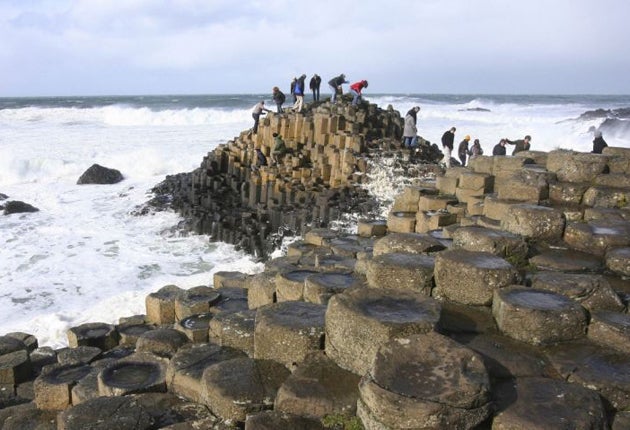A guide to A-road Britain: A2
Dr Johnson famously had no time for the Giant's Causeway – but then he didn't have a bike or a car. David McKittrick thinks the great man would now find kinder words for this road along the stunning Antrim coast

Samuel Johnson must have been in one of his more churlish moods when he grumbled that the majestic Giant's Causeway was "worth seeing, but not worth going to see". His disparaging remark was rendered out of date within half a century of his death by the construction of the amazing Antrim coast road.
Not only did reaching the Causeway became far easier, but the road itself was much more than just a means of communication, since it provided access to a procession of other striking attractions, all well worth going to see. At a stroke, Antrim gained a double wonder with the advent of the road itself. It snakes along within yards of the sea at the foot of cliffs at the edge of the Antrim plateau. Sometimes the scenery is tranquil, sometimes thrillingly dramatic.
The Causeway is Northern Ireland's most visited attraction, bringing tourists on a scale large enough to make Dr Johnson harrumph. Its 40,000 unusually shaped columns, most of them hexagonal, jut out into the north channel of the Irish Sea. They were fashioned by local giant Finn MacCool so that he could cross the sea to fight a rival Scottish giant.
Well, so local folklore has it, though in recent centuries scientists have tended towards the less mythic explanation that its impressive amphitheatres were created by lava flows generated by intense volcanic activity 60 million years ago. From the Causeway on down the coast, sites jostle for attention – so many of them, in fact, that drivers have little realistic chance of fitting them all in during a single day. In any event, the culture of the area tends to frown on rush and hurry. Bushmills whiskey, for example, has been produced in a local town since a licence was granted by King James I in 1608, a century before Dr Johnson was born. Even before that, hard liquor was turned out as far back as 1160 – without licence – by what was described as a "lawless peasantry". Today the distillery is open for tours.
Alcoholic fortification has probably helped steel the nerves of some of those who make the daunting journey across the swaying Carrick-a-Rede rope-bridge which connects the mainland to a small island above a chasm. A bridge of some sort has been in place for more than 300 years, 30 metres above the sea and the rocks.
Much more history is to be found just down the road, where the romantic ruins of Dunluce Castle perch precariously on a wild headland. One 17th-century visitor called it "a palace washed on all sides by the sea". Though offering protection against invaders the sea also has its dangers, as was most obviously seen a couple of centuries ago when the kitchen suddenly plummeted into the waves, taking some of the castle's cooks with it. A fort has been there since the 13th century. In 1588 its defences were strengthened when cannon were salvaged from the Girona, a ship of the Spanish Armada, which hit a reef and sank nearby.
Although the coast road is less than 30 miles long, it features charming little villages and harbours, and a series of picturesque glens. Many visitors can't resist looping through a few of them to take in scenery which varies from the majestic to the merely breathtaking. Many local people speak in a manner which is extraordinarily – it might even be said uncannily – close to a Scottish accent. There are good reasons for this, since on a clear day Scotland can be clearly seen across the Irish Sea. The stretch of water has been more of a link than a barrier, especially in the pre-coast road days when Argyllshire was easier to reach than much of the rest of Ireland: hence the accent.
Much raw geology is on view as the road meanders with cliffs on one side and rocks and beaches on the other, with inlets formed as the waves have crashed, over millions of years, into the land. The Causeway, which has been described as Northern Ireland's rock star, can get more than a quarter of a million visitors a year.
Yet the coast road never seems packed, so that it retains its sense of providing a glimpse back into history. This means that, though it ranks among the UK's areas of outstanding natural beauty, it must be among the least crowded of them. It also has a pleasing lack of commercial development, many of its inns remaining small and traditional. It has also avoided the culture of setting out to extract as much money as possible from its tourists.
Instead it lets its panoramas speak for themselves in a place of legend and myth, where both the historic and the prehistoric are on view. Dr Johnson, who was after all essentially a fair-minded man, would today surely concede that it is all well worth going to see.
Subscribe to Independent Premium to bookmark this article
Want to bookmark your favourite articles and stories to read or reference later? Start your Independent Premium subscription today.

Join our commenting forum
Join thought-provoking conversations, follow other Independent readers and see their replies